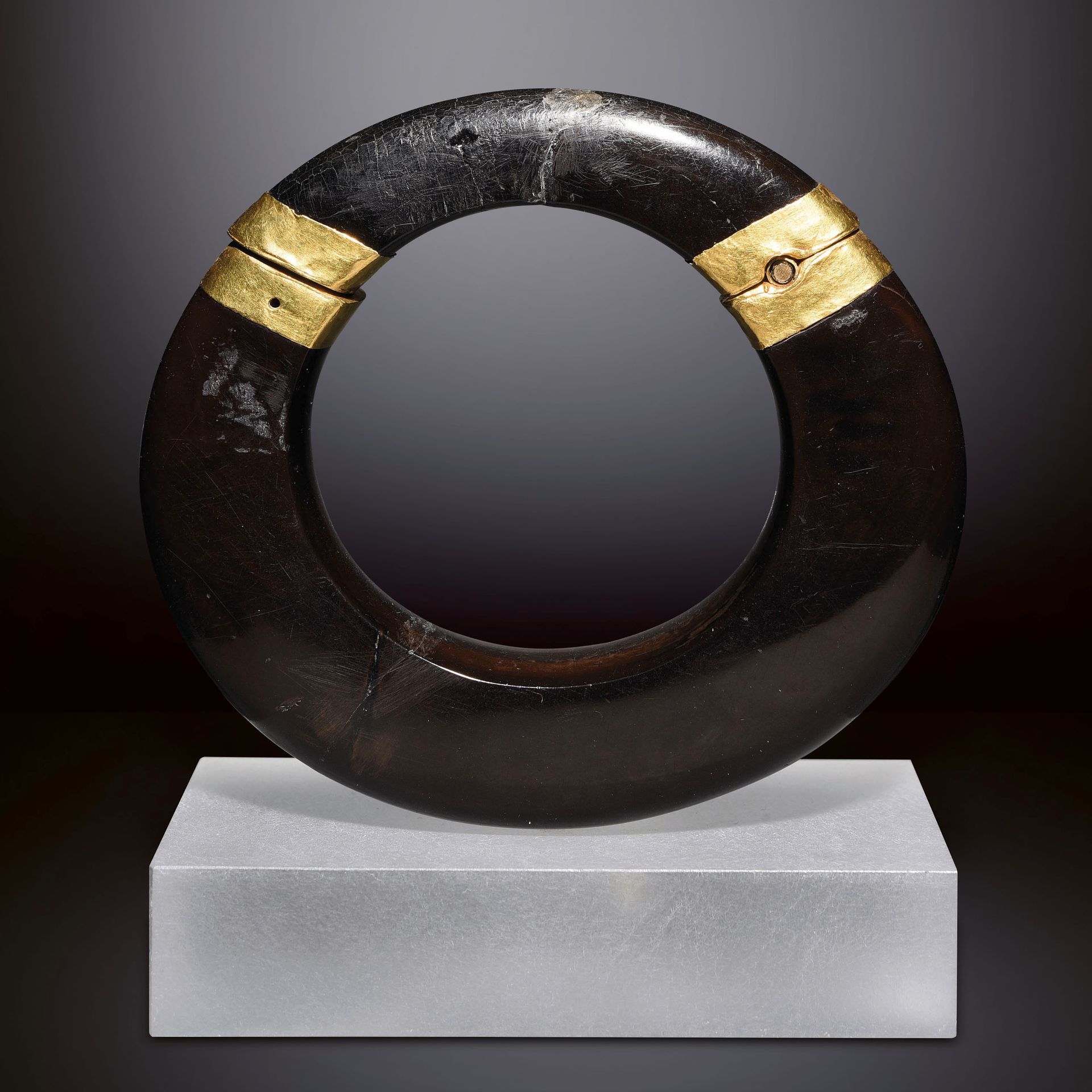Description
BRACELET Roman art, 3rd century AD Jet and gold Diameter 9,5 cm Provenance Former private collection, acquired in 1970-1980, then by descent Private collection, 1998 The bracelet is fashioned from two rounded sticks of jet. The two elements are connected by square clasps fashioned in gold leaf and protecting the end of each rod. Very well preserved. For a similar model see Musée du Louvre, inv. Bj 2233 Jet in Roman times because of its black color, lightness and shiny appearance, jet was highly prized by the Romans of the imperial era in the manufacture of jewelry. But the starting point for the use of this material was the empress Julia Domna and her innate talent for setting fashion trends - such as her way of doing her hair, which was copied by the entire Roman female elite, as well as the empress Salonina and Queen Zenobia. It is said that during her trip to York with her husband Emperor Septimius Severus and their two sons Caracalla and Geta she discovered fascinating amulets and objects made of jet. Her name, Domna in archaic Arabic means "black", in homage to the sun god El-Gabal in his form of black stone. Appreciated and sought after for its magnetic properties, the Romans also used it in the making of protective amulets. Numerous pieces of jewelry have been discovered on the site of Malton in England and are now kept in the Malton Museum. A jet and gold bracelet. The bracelet is fashioned from two rounded rods of jet. The two elements are connected by square clasps modeled in gold leaf and which protect the end of each rod. Very good conservation. For a similar model see Louvre Museum, inv. Bj 2233. Ca. 3rd century A.D. The jet among the Romans because of its black color, lightness and shiny appearance, jet was highly prized by the Romans of the imperial era for the manufacture of jewelry. But the starting point for the use of this material is to be compared to the Empress Julia Domna and her innate talent for launching fashion trends - such as her style of hair, copied by all the Roman female elite as well as Empress Salonina and Queen Zenobia. It is said that during her trip to York with her husband the Emperor Septimius Severus and their two sons Caracalla and Geta she discovered fascinating amulets and objects made from jet - Her name, Domna in archaic Arabic means "black", in tribute to the sun god El-Gabal in his black stone form. Appreciated and sought after for its magnetic properties, the Romans also used it in the making of protective amulets.Many pieces of jewelry were discovered at the Malton site in England and are now kept in the Malton Museum.
58
BRACELET Roman art, 3rd century AD Jet and gold Diameter 9,5 cm Provenance Former private collection, acquired in 1970-1980, then by descent Private collection, 1998 The bracelet is fashioned from two rounded sticks of jet. The two elements are connected by square clasps fashioned in gold leaf and protecting the end of each rod. Very well preserved. For a similar model see Musée du Louvre, inv. Bj 2233 Jet in Roman times because of its black color, lightness and shiny appearance, jet was highly prized by the Romans of the imperial era in the manufacture of jewelry. But the starting point for the use of this material was the empress Julia Domna and her innate talent for setting fashion trends - such as her way of doing her hair, which was copied by the entire Roman female elite, as well as the empress Salonina and Queen Zenobia. It is said that during her trip to York with her husband Emperor Septimius Severus and their two sons Caracalla and Geta she discovered fascinating amulets and objects made of jet. Her name, Domna in archaic Arabic means "black", in homage to the sun god El-Gabal in his form of black stone. Appreciated and sought after for its magnetic properties, the Romans also used it in the making of protective amulets. Numerous pieces of jewelry have been discovered on the site of Malton in England and are now kept in the Malton Museum. A jet and gold bracelet. The bracelet is fashioned from two rounded rods of jet. The two elements are connected by square clasps modeled in gold leaf and which protect the end of each rod. Very good conservation. For a similar model see Louvre Museum, inv. Bj 2233. Ca. 3rd century A.D. The jet among the Romans because of its black color, lightness and shiny appearance, jet was highly prized by the Romans of the imperial era for the manufacture of jewelry. But the starting point for the use of this material is to be compared to the Empress Julia Domna and her innate talent for launching fashion trends - such as her style of hair, copied by all the Roman female elite as well as Empress Salonina and Queen Zenobia. It is said that during her trip to York with her husband the Emperor Septimius Severus and their two sons Caracalla and Geta she discovered fascinating amulets and objects made from jet - Her name, Domna in archaic Arabic means "black", in tribute to the sun god El-Gabal in his black stone form. Appreciated and sought after for its magnetic properties, the Romans also used it in the making of protective amulets.Many pieces of jewelry were discovered at the Malton site in England and are now kept in the Malton Museum.
